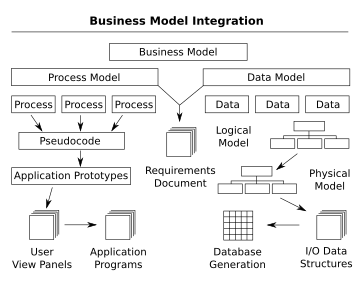
Enterprise modelling is the abstract representation, description and definition of the structure, processes, information and resources of an identifiable business, government body, or other large organization.[2]
It deals with the process of understanding an organization and improving its performance through creation and analysis of enterprise models. This includes the modelling of the relevant business domain (usually relatively stable), business processes (usually more volatile), and uses of information technology within the business domain and its processes.
- ^ Paul R. Smith & Richard Sarfaty (1993). Creating a strategic plan for configuration management using Computer Aided Software Engineering (CASE) tools. Paper For 1993 National DOE/Contractors and Facilities CAD/CAE User's Group.
- ^ Cornelius T. Leondes, Richard Henry Frymuth Jackson (1992). Manufacturing and Automation Systems: Techniques and Technologies. Academic Press, 1992. ISBN 0-12-012745-8, p.97